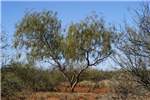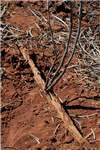Click on images
to enlarge


Photographer: B.R. Maslin

Root sucker. Photographer: B.R. Maslin
, near BRM 8634, ADJUSTED BRM_sml.jpg)
Photographer: B.R. Maslin
, Thomson 91, Photo Lex Thomson, ADJUSTED BRM_sml.jpg)
Photographer: L. Thomson
Botanical name
Acacia pachycarpa F. Muell., Fl. Austral. 2: 408 (1864)
Description
Bushy, tall shrubs or small trees commonly (2-) 3-4 (-6) m tall, ultimate branchlets and phyllodes with a weeping (pendulous) habit, single to several-stemmed at base, crowns may be large when plants grow on favourable sites. Bark dark grey, hard and furrowed on main stems (sometimes breaking with a rectangular fracture) but becoming light grey and smooth on upper branches. Branchlets grey, glabrous, brittle (breaking readily with a clean fracture). Phyllodes broadly linear to very narrowly elliptic, 13-34 cm long, 6-20 mm wide, strap-like, thinly coriaceous, sub-straight to curved, glabrous or (especially when young) with fine, appressed, straight hairs that are difficult to see with the unaided eye, green with a slight to moderate sheen; with 1-5 widely spaced main longitudinal nerves, the minor nerves indistinct, numerous, close together and normally longitudinally anastomosing; apex gradually narrowed to a drawn-out, non-spiny point. Inflorescences simple, 1 or 2 within axil of phyllode; peduncles 2-22 mm long, glabrous; spikes 3-6 cm long, ±1 cm in diameter when dry, the large creamy yellow flowers widely spaced along the axis of the spike. Flowers 5-merous, large (3 mm long); sepals united, the calyx ±truncate. Pods narrowly oblong, rounded over the seeds but not or scarcely constricted between them, often breaking between the seeds, 7-15 cm long, 1-2 cm wide, woody, indehiscent, straight to shallowly curved, finely longitudinally wrinkled, glabrous, slightly shiny, yellow-brown. Seeds transverse in the pods, broadly ellipsoid to ±globose, 5-9 mm long, slightly shiny, pale brown to black; not obviously arillate.
Characteristic features
Shrubs or trees with pendulous branchlets and phyllodes. Phyllodes strap-like, very long, and narrow (13-34 cm x 6-20 mm). Spikes large (3-6 cm long, ±1 cm wide), the creamy yellow flowers large and widely spaced. Pods large (7-15 cm x 1-2 cm), woody, yellow-brown.
Distribution and ecology
The main area of occurrence of this species is the Tanami Desert in an area straddling the Western Australian - Northern Territory border; there are, however, disjunct occurrences on the edge of the Pilbara region from near Onslow (from Minderoo Station and Yanrey Station) and Telfer Mining Centre. Over its range A. pachycarpa commonly grows along drainage lines in clay depressions and clay pans but is also found in sandy alluvium along creeks and in sandy loam. The Minderoo and Yanrey populations form single-species communities in the drainage foci on cracking clay plains with Mitchell Grass (Astrebla pectinata). Although A. pachycarpa is reportedly salt tolerant in its natural habitat, under trial conditions it ranked amongst the least tolerant of the Acacias that were screened (Aswathappa et al. 1987). Additional ecological information is given in Doran and Turnbull (1997).
Flowering and fruiting period
Over its entire geographic range flowering and fruiting is variable. In the Pilbara flowers have been collected in May and pods with mature seed in September.
Affinities
Acacia stenophylla is similar to A. pachycarpa in having long, strap-like phyllodes, pale-coloured flowers and long, woody pods; it also grows near watercourses (see A. stenophylla for distinguishing characters). Acacia pachycarpa may possibly be related to A. cuthbertsonii (not confirmed as occurring in the Pilbara) which is readily recognized by its non-weeping branchlets and phyllodes, hairy branchlets and smaller phyllodes and spikes. In the past A. pachycarpa has sometimes been confused with A. ancistrocarpa but the two species are not particularly closely related.
Notes
In its natural habitat A. pachycarpa is reported to be relatively fast growing but in (limited) trials its growth rate has generally been modest (about 1 m per year, see Doran and Turnbull 1997). It regenerates from coppice growth and from seed, and seems also to root sucker after fire (or other disturbance).
The wood is heavy (1010 kg/m3) and has potential as a fuel; the species also has potential as an ornamental in arid areas and to provide low shade (Doran and Turnbull 1997), however, its propensity to root sucker may well constrain its use.
The Tanami plants at least are heavily grazed (Tindale and Maconochie 1972, as A. crassifrugis).
An unpleasant, foetid, 'gidgee'-like odour (similar to that of A. cambagei and A. georgineae) is emitted from the flowers and green pods, and when the phyllodes and branches are broken.
Conservation status
Not considered rare or endangered.
Origin of name
The botanical name is derived from the Greek pachys (thick, stout) and karpos (fruit) in reference to the characteristically thick, woody pods.
References
Aswathappa, N., Marcar, N.E. and Thomson, L.A.J. (1987). Salt tolerance of Australian tropical and subtropical acacias. pp. 70-73. In: J.W. Turnbull (ed.) Australian Acacias in developing countries. Proceedings of an international workshop held at the Forestry Training Centre, Gympie, Australia, 4-7 August 1986. ACIAR Proceedings No. 16. pp. 196. (Australian Centre for International Agricultural Research: Canberra.)
Doran, J.C. and Turnbull, J.W. (1997). Australian trees and shrubs: species for land rehabilitation and farm planting in the tropics. ACIAR Monograph No. 24. pp. 384. (Australian Centre for International Agricultural Research: Canberra.)
Tindale, M.D. and Maconochie, J.R. (1972). A new species of Acacia from the Northern Territory. Contributions from the New South Wales National Herbarium 4(5): 267-268.
